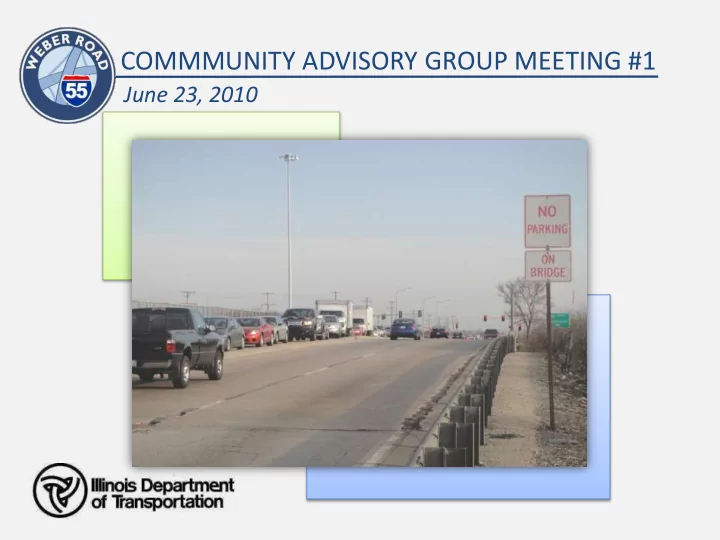

COMMMUNITY ADVISORY GROUP MEETING #1 June 23, 2010
INTRODUCTIONS Illinois Department of Transportation Clark Dietz, Inc. Huff & Huff, Inc. Planning Communities, LLC. Community Advisory Group (CAG) members
MEETING OUTLINE Agenda Review the public involvement process Discuss the initial findings Define the transportation problem Establish the next steps in the process CAG Notebooks Meeting materials Reference materials
PUBLIC INVOLVEMENT PROCESS Context Sensitive Solutions (CSS) review Ground rules Role of the Community Advisory Group (CAG) Meeting timetable
WHAT IS CONTEXT SENSITIVE SOLUTIONS? Context Sensitive Solutions (CSS) is an interdisciplinary approach that seeks effective, multimodal transportation solutions by working with stakeholders to develop a cost- effective transportation facility which will fit into and reflect the project’s surroundings – its “context” . An IDOT CSS project: Considers project’s context Fosters communication and collaboration Environmentally sensitive Exercises design flexibility
WHY USE CONTEXT SENSITIVE SOLUTIONS? Open and transparent process Find solutions to transportation and community issues Add lasting value to community, environment and transportation system Create working relationships
THE CSS PROCESS Identify Context Define and Evaluation Define Preferred Evaluate Criteria Problem Alternative Alternatives Identify Stakeholders Considerations Stakeholder Considerations / Community Assets Environmental Considerations / Compatibility with the Environment Engineering Considerations / Transportation Needs
IDENTIFYING CONTEXT VISIBLE Economics Safety & Environment REGIONAL Health Mobility Aesthetics Social & Right-of-Way Cultural Constraints INVISIBLE LOCAL Land Use
IDENTIFYING CONTEXT
REGIONAL CONTEXT I-55 at Weber Rd
LOCAL CONTEXT Rodeo Dr./119 th St Colleges Windham Pkwy. Residential Parks/Open lands Normantown Rd. Warehouse and Distribution Farmland Businesses Civic Romeo Rd./135 th St
STAKEHOLDER INVOLVEMENT PLAN (SIP) Inventory of stakeholders Responsibilities of participants Description of opportunities for stakeholder participation Schedule of public involvement activities Will be available on the study website
PUBLIC INVOLVEMENT PROCESS Context Sensitive Solutions (CSS) review Ground rules Role of the Community Advisory Group (CAG) Meeting timetable
PUBLIC INVOLVEMENT PROCESS Context Sensitive Solutions (CSS) review Ground rules Role of the Community Advisory Group (CAG) Meeting timetable
THE COMMUNITY ADVISORY GROUP Assists with: Defining context Establishing purpose and need Developing alternatives Community Advisory Group Could consist of: (CAG) Community leaders Interested stakeholders Responsibilities include: Interest General Groups Public Providing input Local Businesses Attending meetings Collaborating with the Project Study Group
TECHNICAL ADVISORY GROUPS Assists with: Evaluation of alternatives Specific issues Technical Could consist of parties interested in: Advisory Group Transportation & engineering (TAG) Environment & land Use Responsibilities include: Provide input Attend TAG meetings Collaborate with the Project Study Group
PROJECT STUDY GROUP Clark Dietz, Inc. & Sub-Consultants
PROJECT STUDY GROUP Community Advisory Group (CAG) Project Study Group (PSG) Clark Dietz, Inc. & Sub-Consultants Technical Advisory Group (TAG)
PUBLIC INVOLVEMENT PROCESS Context Sensitive Solutions (CSS) review Ground rules Role of the Community Advisory Group (CAG) Meeting timetable
MEETING TIMETABLE
INITIAL FINDINGS Regional growth Future growth Traffic Crashes Context Survey results
PROBLEM STATEMENT WORKSHOP What are the transportation problems at the I-55 at Weber Road interchange?
CONSIDERATIONS Economics VISIBLE Safety & Health Environment INVISIBLE Mobility Aesthetics Social & Right-of-Way Cultural Constraints Land Use LOCAL REGIONAL
THANK YOU! Community Advisory Group Meeting #2 August 2010
Recommend
More recommend